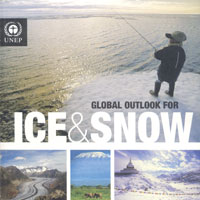|
|
The Himalaya is the water tower that is the source of water for over one billion people. Three of the region's greatest rivers, Indus, Ganga and Bramhaputra start close to Mansarovar. From their sources in eastern Tibet, the Yangtse flows to the East China Sea, the Mekong goes down to Vietnam, the Irrawady and Salween flowdown through Burma to the Bay of Bengal.
What happens to the snow and ice in the Himalaya will determine the future of agriculture in countries downstream, influence the growth of cities and the future of hydropower dams.
'Disappearance of glaciers will have major consequences on water resources, especially in regions such as the Himalayas-Hindu Kush,the Andes, Rocky Mountains and the European Alps where many dry-season river flows depend on glacier meltwater,' warns UN Environment Program in a recently released book, Global Outlook for Ice & Snow.
Ancedotal evidence from the Himalaya about glaciers receding dramatically even within one generation is backed up by evidence that global glacial retreat in the past 100 years, and especially since the 1980s, is related to global warming.
Global Outlook for Ice & Snow examines the dynamic interlinkages between polar ice, ice on land, permafrost and glaciers and how they are being affected by global climate change. The Intergovernmental Panel on Climate Change (IPCC) which shared this week's Nobel Peace Prize with Al Gore in its Fourth Assessment Report concluded that most of the global warming over the past 50 years is due to anthropogenic greenhouse gas emissions.
That should have clinched the issue, but there are still skeptics. The trouble is, by the time we know for sure whether climate change is a result of human carbon emissions or not it will be too late to do anything about it.
The UNEP book is full of fascinating facts, trends and predictions. For example, the North American Arctic is warming twice as fast as any other region on the planet. Antarctica is not warming as fast, but may pick up by the end of the century. Mean snow cover in North America is declining at 1.3 percent a year, this means less sunlight is reflected and there is positive feedback to global warming.
In its section on the Himalaya, the book notes that there has been a doubling of glacial retreat in the Himalaya since the 1970s. Even if global temperatures rise by only 1 degree by 2100, which is the optimistic low scenario, scientists estimate that Himalayan glaciers will decline by 43 percent. If global temperatures rise by 6 percent (pessimistic high scenario) then Himalayan glaciers would shrink by 83 percent.
Reduction of snow cover is already have dramatic effect on water resources. Mountain snow contributes to water supplies for one-sixth of the world's population. As rivers run dry in the dry season, there would widespread human misery and perhaps water wars.
The book has a dire warning for the Himalaya: 'The result of glacier loss is not only direct tghreat tolives, but also great risks of poverty, reduced trade and economic decline. This poses major political, environmental and social challenge in the coming decades.'
So, what is to be done? The book cites the IPCC's conclusion: 'Greenhouse gases must stop increasing and start decreasing no later than 15-25 years from now.' Economists have said this can be done without a decline in living standards. But do the world's main carbon emitters (the US, China, India) have the political will to do so?
Related Articles
. THE BIG THAW
. Himalayan meltdown
. An inconvenient peace prize



